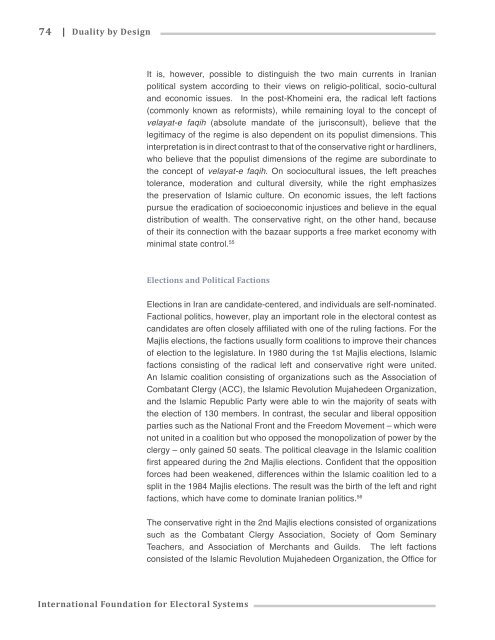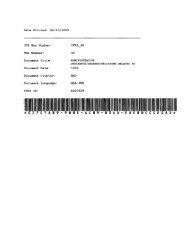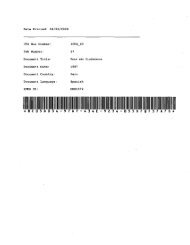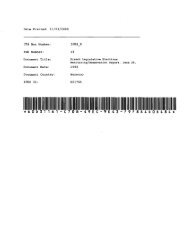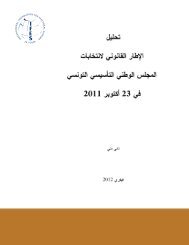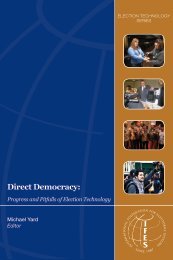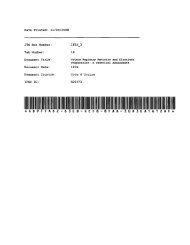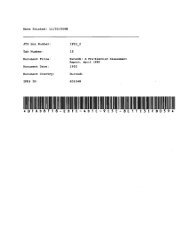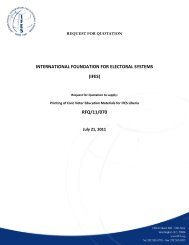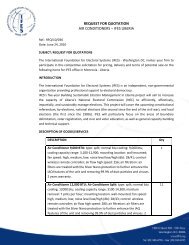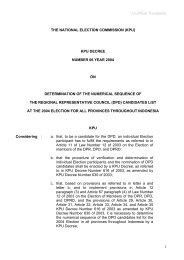Duality by Design: The Iranian Electoral System - IFES
Duality by Design: The Iranian Electoral System - IFES
Duality by Design: The Iranian Electoral System - IFES
Create successful ePaper yourself
Turn your PDF publications into a flip-book with our unique Google optimized e-Paper software.
74<br />
<strong>Duality</strong> <strong>by</strong> <strong>Design</strong><br />
It is, however, possible to distinguish the two main currents in <strong>Iranian</strong><br />
political system according to their views on religio-political, socio-cultural<br />
and economic issues. In the post-Khomeini era, the radical left factions<br />
(commonly known as reformists), while remaining loyal to the concept of<br />
velayat-e faqih (absolute mandate of the jurisconsult), believe that the<br />
legitimacy of the regime is also dependent on its populist dimensions. This<br />
interpretation is in direct contrast to that of the conservative right or hardliners,<br />
who believe that the populist dimensions of the regime are subordinate to<br />
the concept of velayat-e faqih. On sociocultural issues, the left preaches<br />
tolerance, moderation and cultural diversity, while the right emphasizes<br />
the preservation of Islamic culture. On economic issues, the left factions<br />
pursue the eradication of socioeconomic injustices and believe in the equal<br />
distribution of wealth. <strong>The</strong> conservative right, on the other hand, because<br />
of their its connection with the bazaar supports a free market economy with<br />
minimal state control. 55<br />
Elections and Political Factions<br />
Elections in Iran are candidate-centered, and individuals are self-nominated.<br />
Factional politics, however, play an important role in the electoral contest as<br />
candidates are often closely affiliated with one of the ruling factions. For the<br />
Majlis elections, the factions usually form coalitions to improve their chances<br />
of election to the legislature. In 1980 during the 1st Majlis elections, Islamic<br />
factions consisting of the radical left and conservative right were united.<br />
An Islamic coalition consisting of organizations such as the Association of<br />
Combatant Clergy (ACC), the Islamic Revolution Mujahedeen Organization,<br />
and the Islamic Republic Party were able to win the majority of seats with<br />
the election of 130 members. In contrast, the secular and liberal opposition<br />
parties such as the National Front and the Freedom Movement – which were<br />
not united in a coalition but who opposed the monopolization of power <strong>by</strong> the<br />
clergy – only gained 50 seats. <strong>The</strong> political cleavage in the Islamic coalition<br />
first appeared during the 2nd Majlis elections. Confident that the opposition<br />
forces had been weakened, differences within the Islamic coalition led to a<br />
split in the 1984 Majlis elections. <strong>The</strong> result was the birth of the left and right<br />
factions, which have come to dominate <strong>Iranian</strong> politics. 56<br />
<strong>The</strong> conservative right in the 2nd Majlis elections consisted of organizations<br />
such as the Combatant Clergy Association, Society of Qom Seminary<br />
Teachers, and Association of Merchants and Guilds. <strong>The</strong> left factions<br />
consisted of the Islamic Revolution Mujahedeen Organization, the Office for<br />
International Foundation for <strong>Electoral</strong> <strong>System</strong>s


